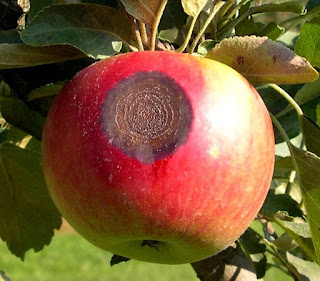Two extended wetting events in the past ten days have brought an increase in summer disease pressure, especially bitter rot at our AREC in Winchester: Jul 22-23, wet 13 hr at 72° with 1.3 in. of rain and Jul 28-29, wet 17 hr at 73-63° with 2.25 in. of rain. Be aware that, as a general guideline, two inches of rain will deplete most protective fungicide residues.
 |
| Bitter rot on Idared apple. |
 |
| Same fruit as above, cut to show the diagnostic cone-shaped progression of the bitter rot fungus into the fruit. |
Since July 1, rainfall has been scattered, with a total of 3.66 in. for the NEWA station at Gadino Cellars in Rappahannock County, VA. Augusta County Barren Ridge, Fishersville rainfall total was less with 1.98 in. in July, but an additional 1.17 in. on Aug 1. July total rainfall was was generally lighter for Albemarle County ranging from 1.89 in. at Batesville, to 0.57 in. at Carter Mt.
As of Aug 1, accumulation of wetting hours since Apr 30 at Tyro, 941 ft elevation was 512 hr, with the 250-hr threshold reached on June 12. The NEWA station at Gadino Cellars (elev. 665 ft, in Washington, VA) passed the threshold of 250 ACW June 16, and has now recorded 394 wetting hours since May 1. The NEWA station at Fishersville also passed the 250-hr threshold June 16 and now has 390 ACW. Three Albemarle County NEWA stations have also passed the 250-hr threshold, listed with ACW as of Aug 1 and date the was threshold reached: Batesville (367 ACW, July 2); Crozet (309 ACW, July 5); Carter Mt. (292 ACW, July 6).
